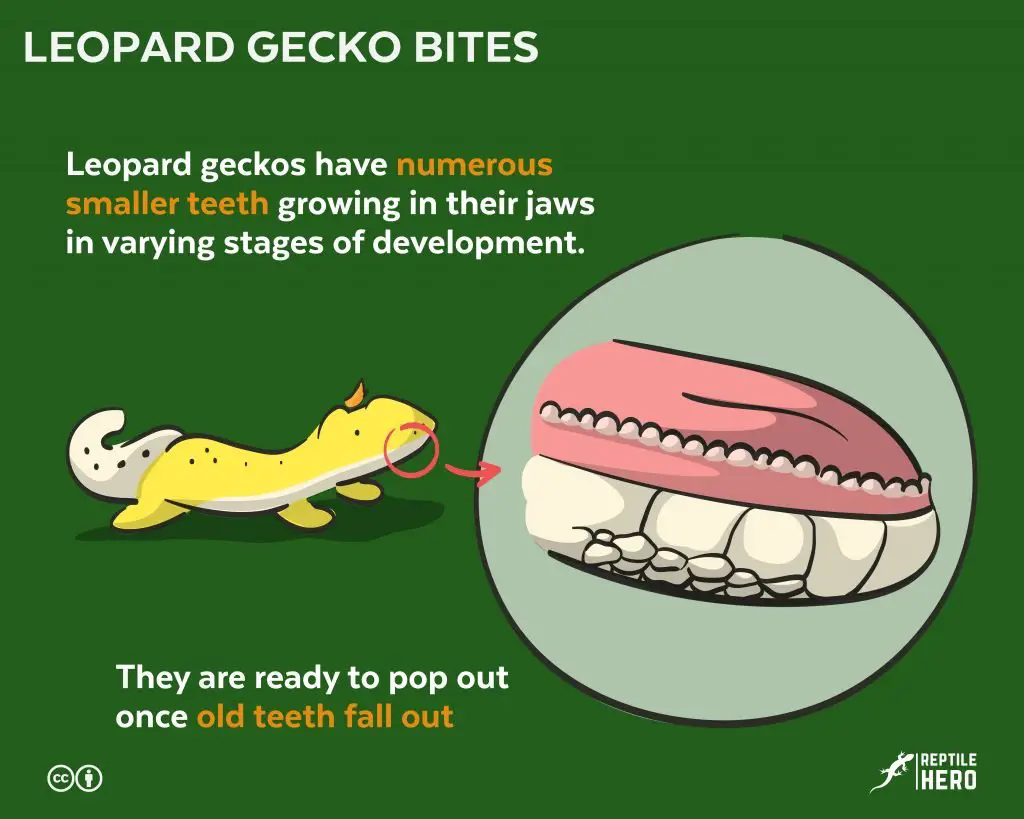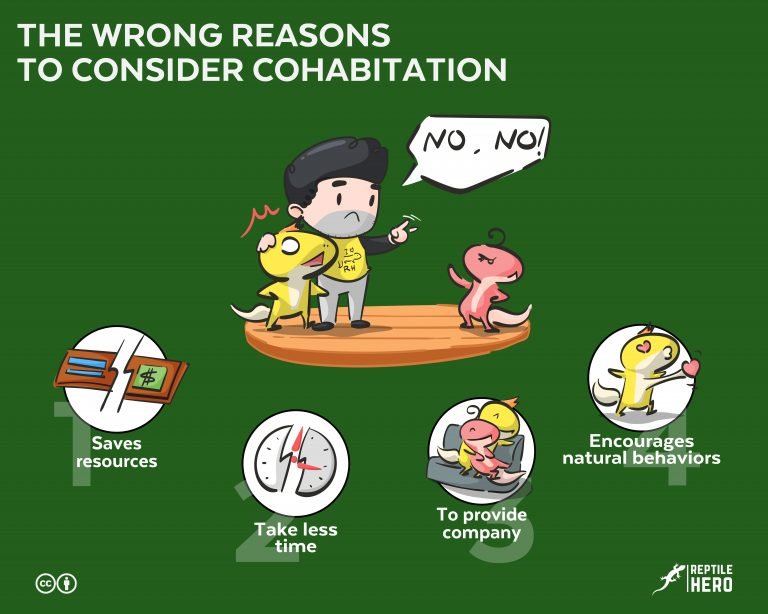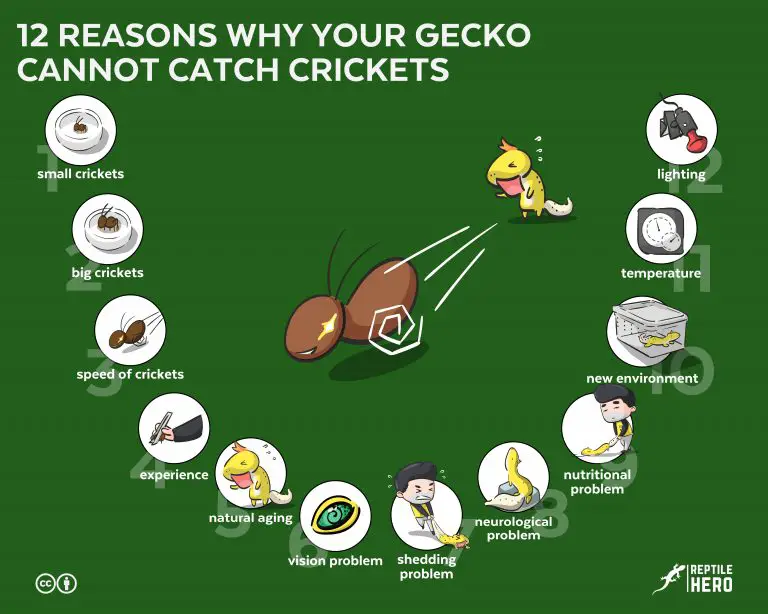Why Does Your Leopard Gecko Bite You? (5 Simple Reasons!)
Because leopard geckos are widely known to be very docile reptiles, many people have the impression that they would never bite. However, many new and experienced keepers would definitely disagree. In fact, leopard geckos can bite you for several reasons!
The average leopard gecko is likely to bite its owner and other people due to shock, apprehension, aggression, hand-feeding, and mating behavior. Depending on the force the gecko applies, the pain from its bite can be mild or severe. Generally, a leopard gecko’s bite is harmless if the wound is promptly and properly treated.
Can a gecko bite break through your skin? Is there a way to get it to release its hold on you without hurting your beloved gecko and yourself? Find out the answers to these important questions by scrolling on!

1. Shock
A leopard gecko that is startled can be quick to bite people near it. This commonly happens when a gecko is touched abruptly or shocked by sudden sounds around it.
In such cases, the startled gecko instinctively bites to protect itself from any potential danger as it has been taken by surprise.
You’re likely going to see this instinctive biting response more commonly in geckos that are young, newly acquired, and those that have eye issues. This is true for most other reasons behind biting in geckos as well.
But even if you’re gecko has been in your care for years, startling it can still trigger a reflexive and defensive bite.
Learn more about lizard bites in general in our article on dangerous bites.
So when you’re handling your gecko, especially when you do so outside its tank, avoid suddenly booping it in the snout with your nose or finger. You can still get bitten if you just sneakily poke it in any other part of its body out of the blue though.
Placing your finger or any other body part near its mouth and then startling it just pretty much ensures that you’re gonna get bitten much faster.
Don’t take your gecko anywhere that can be too noisy either. You see, like most other animals, geckos are quite sensitive to sounds as well. In other words, they may be taken aback by sounds we may not even pick up on.
2. Apprehension
Stressed Leopard geckos have a higher chance of biting people due to their heightened sense of apprehension. Oftentimes, this is observed when a gecko has yet to acclimate and if it’s sick or having shedding issues.
Honestly, you could expect most other animals to bite or at the very least snap at you if it doesn’t feel safe. This is why it’s highly discouraged to immediately pick up and constantly handle a gecko that clearly isn’t familiar or comfortable with you yet.
Plus, since we technically are big and scary predators in the eyes of a small leopard gecko, it’s understandable that they would be highly cautious around us.
For leopard geckos to ensure their safety and survival, they’d rather bite and lash out at you than wait for you to deal a lethal attack first.
You’d typically come across similar stories of geckos defensively biting more readily when they are still in the process of shedding their skin. Wondering why they’re quick to bite when they are hurt or shedding? The answer is simple and quite self-explanatory.
A gecko that is sick or injured is in greater danger of being preyed upon as it may be less effective in protecting itself in such a vulnerable state. Hence, it becomes much more reactive and defensive to possible dangers around it.
Moreover, it’s important to remember that geckos also shed skin from their eyes. So not being able to clearly see their surroundings could further distress them.
3. Aggression
When humans violate their boundaries, the leopard gecko may aggressively bite the offending intruder. Both male and female leopard geckos can be territorial to a certain extent so sex doesn’t necessarily determine whether or not a gecko will bite.
Like any other living being on earth, leopard geckos can bite you out of anger and aggression. But they’ll typically try to give you a clue to get away from them first.
If you ignore a leopard gecko’s warning signs to back off, then prepare to get bitten.
Most commonly, leopard geckos will repeatedly bob their heads up and down as a way to say “leave me alone.” This is normally seen among geckos that are rescued or kept in shelters [1]. But regular captive-bred leos may do this as well.
Though considered unusual, leopard geckos may also display the following warning signs toward humans:
- Standing tall with legs stretched out
- Extending and/or waving the tail
- Hissing or breathing loudly
Consider the fact that geckos have individual personalities and temperaments as well. While the great majority are considered friendly and tame, some can be intolerant of physical contact.
Don’t force interaction with your beloved gecko, especially if it’s already showing you that it doesn’t like being held or petted.
Explore the other possible reactions of geckos towards being touched in our article on petting geckos.
“Hot female” leos, for instance, are known to be a lot more aggressive than the average female leopard gecko. They can be pretty bitey too. Simply put, you can’t expect a gecko to just enjoy being handled just because it’s female or supposedly more docile.
4. Hand-Feeding
Leopard geckos may also bite their owner’s hands or fingers as a feeding response. More often than not, this is observed in geckos that have been hand-fed.
Hand-feeding geckos is basically a surefire way to get bitten by your gecko again and again.
Once you have established an association with food and fingers for your gecko, you can expect it to try and take a chomp on you. However, they are more likely to bite your fingers if you wiggle them around to mimic the movement of live feeder worms.
Additionally, if you handle their food being offering it to your geckos as prey, then your hands are likely to smell like food—even just a bit. So the movement of your finger combined with the prey’s scent could confuse your gecko and make it mistake your fingers for food.
Don’t worry, though! Leopard geckos readily let go after realizing they have not bitten on food.
But if you want to avoid having your leo form such a strong association between your hand and its food, don’t hand feed it. Either feed your precious gecko with tongs or let it hunt for live prey in its tank. Such feeding methods are more enriching for geckos.
5. Mating Behavior
During breeding season leopard geckos are likely to bite humans if they sense another gecko’s pheromones on the person’s skin.
Unless you are a breeder, highly interested in the topic, or are greatly familiar with leopard geckos in general, then you might not even have thought of this possibility.
Quite frankly though, this is more common in pet crested geckos than it is in leopard geckos. So I can see why mating may not immediately be thought of when regular pet parents are bitten by their leos.
Discover how these species compare with each other in our article on the differences between leos and cresties.
However, this being relatively unheard of doesn’t mean that it never happens. If you have multiple leos in your care and you don’t wash your hands in between handling all of them, you may get bitten.

This happens when your hands are covered with the pheromones of other geckos during the mating season—from January/March to July/September [2, 3].
Male leopard geckos gently nip or bite at female geckos who they want to mate with. But they will aggressively and repeatedly deliver damaging bites on other males. Unreceptive female leopard geckos on the other hand will bite at unrelenting males.
You can expect the same reactions from your little leopard geckos when they smell such pheromones on you.
What Does a Leopard Gecko Bite Feel Like? Does It Hurt?
The feeling of getting bitten by leopard geckos can vary greatly. Owners and experts alike have experienced bites ranging from just a slight pinching pressure, subtle stinging sensation, to bloody and painful.
A leopard gecko’s bite doesn’t have to inflict severe and bloody damage for it to hurt. I mean, just think of paper cuts!
Normally though, a bite or nip from leopard geckos doesn’t hurt much at all. If anything their bite will likely only feel like a pinch. Others don’t even realize that their gecko has bitten them until they look down and see it in action.
Usually, a gentle gecko bite will just look like a tiny scratch with no blood whatsoever. Then again, we all have different levels of pain tolerance.
Just keep in mind that leopard geckos are more than capable of breaking the skin and drawing blood. I know a good handful of people who have had their fair share of bite marks from scared and feisty rescue leos.
In very rare cases, however, leopard geckos can inflict serious damage that could bleed profusely. Such injuries require immediate medical attention and treatment.
Can you die from a leopard gecko bite?
No cases of death have ever been documented in humans due to leopard gecko bites. This is because leopard geckos are relatively harmless. A leopard gecko neither has venom nor carries rabies so its bite is not commonly considered to be dangerous.
Leopard Gecko Teeth and Biting
On average, leopard geckos possess more or less 100 small conical teeth that emerge directly from their bones. This primarily allows them to firmly grip live prey when hunting and eating. Other than that, geckos also use their teeth to defend themselves and compete with other geckos by biting.
Each tooth is periodically replaced throughout the leopard gecko’s life, a condition called polyphyodonty [4]. The overall replacement generally happens every 3 months or so, but a single tooth can be replaced as quickly as 6 weeks or 1 ½ month.
What I find even more interesting about leopard gecko teeth, though, is that they have numerous smaller teeth growing in their jaws in varying stages of development. They are ready to pop out once old teeth fall out.
How Do You Get a Gecko to Release Its Bite on You? (2 Ways)
Although it is not recommended to force a leopard gecko to release its bite, there are two effective techniques that can be used to encourage it to let go:
- Gently dripping clean water on top of its head
- Carefully holding an alcohol-soaked cloth near its nose
That said, you should never force the gecko off you while it’s biting down. I know that this is easier said than done but doing so could do more harm than good to both you and the gecko sinking its teeth into your skin.
If you flail upon getting bitten, the gecko may bite down harder.
Then, at best, your gecko may learn that biting you will get you to stay away. But, at worst, you could fling the gecko and cause serious injury to its neck and jaw—which could result in its death.
Now for neglected, traumatized, and rarely handled geckos, it may be even harder to have them let go willingly after biting. So try to be as calm and patient as you can throughout the ordeal.
Further Questions
When do geckos bite humans?
A gecko may bite humans whenever it is startled or agitated. To name a few cases, a leopard gecko may bite while it is being soaked or bathed, petted or handled, relocated, and/or fed. They may also bite someone seemingly out of the blue when shocked.
Can you make your leopard gecko stop biting you?
Owners can get their leopard geckos to stop biting them by making themselves more familiar with the animals in question. Proper handling must be done to show the gecko that their keeper will not harm or endanger them. Keeping them well fed while providing optimal husbandry is a great method as well.
Is there anything you can do to avoid getting bitten by a gecko?
To avoid getting bitten by a gecko, owners can: 1) wear protective gloves for handling, 2) familiarize a gecko with their scent and voice, 3) approach a gecko slowly and calmly, 4) respect a gecko’s boundaries, 5) give a gecko sufficient time and space to acclimate, and 6) wash their hands before and after handling other geckos.
How should you treat a regular leopard gecko bite?
After getting bitten by a leopard gecko, people need to thoroughly wash the wounded area with clean water and antibacterial soap to prevent infections. Then flush it with an antiseptic solution (here on Amazon). If the bite wound is bleeding, apply pressure until it stops. Finally, apply some triple antibiotic ointment before bandaging it.
What happens if human blood ends up on the gecko’s mouth after biting?
The effects of ingesting blood in geckos after biting humans are largely unknown as it doesn’t happen often. However, considering that geckos are natural carnivores, the accidental consumption of human blood is unlikely going to hurt them. Unless the bitten human carries blood-borne diseases that can affect a gecko, it is unlikely to be harmed.
Summary of Why Your Leopard Gecko Bites You
A leopard gecko normally won’t bite unless it is provoked. They may bite people, including their owners, because of shock, apprehension, aggression, feeding behavior, and mating behavior.
Fortunately, most cases of leopard gecko bites are not severe. Keepers and breeders generally report only shallow bite wounds that don’t result in significant bleeding. However, leopard geckos can indeed bite deeply and draw a lot of blood with enough force.
Sources
[1] https://www.americanhumane.org/app/uploads/2016/08/op-guide-reptilecare.pdf
[3] https://www.vetfolio.com/learn/article/leopard-geckos-husbandry-nutrition-and-breeding
[4] https://www.frontiersin.org/articles/10.3389/fphys.2021.576816/full

![Do Geckos Fart? [4 Potential Reasons]](https://www.reptilehero.com/wp-content/uploads/2021/05/why-geckos-fart-cc-768x614.jpg)

![Do Geckos and Reptiles Dream in Their Sleep? [What Science Says]](https://www.reptilehero.com/wp-content/uploads/2021/07/Gecko-Sleeping-Infographic-768x614.jpg)
![14 Reasons For Having A Gecko [+7 More That Your Child Will Love]](https://www.reptilehero.com/wp-content/uploads/2021/04/Reason-Kids-Gecko-As-a-Pet-768x614.jpg)

